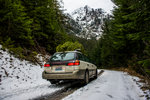
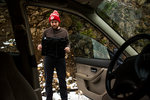
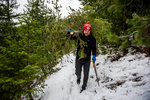
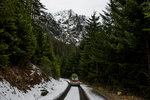
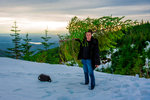
Partway up the slope of Mount Ellinor, trudging on a crusty layer of snow, Chronicle photographer Jared Wenzelburger slipped and went sliding down the hillside.
“How many falls is that?” I asked as he struggled to his feet, down below the trail.
“I think that’s eight — nine!” he said, falling again.
In his jeans and canvas sneakers, Jared tagged along gamely as we scoured the forest. I’d asked him to accompany me on a hunt for The Chronicle’s office Christmas tree. He’d missed the part where I said we’d be traipsing through the national forest.
In my experience, finding a Christmas tree has always meant walking among neat rows of evenly sized evergreens in a field somewhere. For $40 or so, the employees will cut down your tree, haul it back to the barn and load it onto your car. Simple enough, but when I learned Washington’s national forests offer $5 to $10 Christmas tree permits, I conjured visions of wandering the wilderness with a saw, returning with the best tree Mother Nature had to offer, cementing my status as the newsroom Mountain Man.
I called the headquarters of the Olympic National Forest to ask for guidance. For $5, I was told, I could obtain a permit, putting a 600,000-acre tree farm at my disposal. As long as I avoided cutting a white pine and selected a tree 100 feet or more from a trail, I was good to go.
This was going to be simple, I thought. How hard could it be to find a tree in the forests of the Evergreen State?
Friday morning, Jared and I headed to the ranger station and got our permit. The Mount Ellinor Trail, we were told, was a popular one this year for tree hunters. Having been up Ellinor earlier this year, I had a pretty good idea of what we were in for, and I was thrilled at the chance to witness its incredible scenery again.
In Hoodsport, we turned off U.S. Route 101 and headed for the forest. We drove along Lake Cushman, then veered onto the rutted dirt forest road leading to the trail. We weaved up the mountainside, steep embankments falling away below.
Before long, we ran into snow, and I followed ruts that other cars had left behind. As we climbed, the snow got so deep that at times I could hear the underside of my car scraping the top layer of crust.
Half a mile or so before the trailhead, I called it quits. The snow was getting ever deeper, and I feared I would get even my trusty Subaru stuck if I tried to go further. The deep ruts and hard snow had made it impossible to turn around — I had no more control over my car than a conductor has over a train. I’d simply have to back down the mountainside until I found a spot to turn around.
That was a problem for later. First, we had to find a tree. We hiked to the trailhead, looking out at a spectacular vista. From our overlook, we could see the Puget Sound, Mount Rainier, Mount Adams and Mount St. Helens, as shafts of sunlight worked their way across the landscape.
Once we reached the actual trail, we set off into the forest, Jared wielding a camera and me a saw. We hiked up the spine of a hillside, spotting worryingly few trees that looked promising. Most of the surrounding forest was made up of trees much too tall to fit in The Chronicle newsroom. The few appropriately sized trees nearby had only sparse, uneven limbs.
“Remember if you bring us a bad tree we’ll never let you live it down,” Chronicle editor Natalie Johnson had told me the evening before our expedition.
I was beginning to get worried.
Eventually, we reached the point where the access trail joined the main trail. Turning right would have led us toward the summit, up steeper slopes and thinner forest. We turned left, hoping the trail would lead to gentler terrain and better trees.
Winding through switchbacks, we found a few slightly better options, but they were far too close to the trail. Even then, they weren’t the full-figured trees I was used to choosing from.
We hiked on until we came to the junction for the lower access trail, leading back to the trailhead. We thought about settling on a certain tree or two, but each time decided to wait and see what the last stretch of trail had to offer.
Finally, a few hundred yards from where we’d started, we found a copse of trees that were markedly better than anything we’d seen before. Looking down from the trail, they seemed to have full branches and heights that were just about perfect. We picked our way down through the snow, Jared falling more than a few times, and started bushwacking our way through the branches.
Up close, none of the trees were quite perfect. Growing up in close proximity, most were bare on one side where they butted against another tree. We trudged on, pushing branches aside and stopping often so Jared could regain his footing after another fall, wipe the snow off his camera lens and continue the search.
Finally, we spotted a tree standing alone that looked perfect — 6 feet tall, full on all sides and branches evenly spaced. I walked up, prepared to cut it down and start the trek back to the car. Upon closer inspection, though, I saw the needles near the bottom had turned brown, and sap was oozing out of the trunk at its base.
“If you bring us a bad tree,” I heard in my head, “we’ll never let you live it down.”
We continued the search.
Above and below the trail, we ambled through the snow, at times following our footprints back to a tree we’d just visited, to see how it compared with another just ahead. Perfection proved elusive.
Jared fell and banged his knee on a rock, then slipped again and sent a branch slicing through the seat of his pants. For all the cuts and bruises, he was a good sport, but I realized I should probably settle on a tree soon before further calamity arose.
Finally, we returned to a tree Jared had spotted a little ways above the trail. I grabbed onto branches and roots to claw my way up the hillside, then gave Jared a hand as he followed. Panting a little, we inspected our tree.
A Douglas fir, it was just about the right height, and the branches were spaced evenly enough to hold plenty of ornaments without gaps. The backside of the tree, though, was almost completely bare, and its trunk was a little crooked near the base. After one last look around, just to make sure the perfect tree wasn’t hiding in plain sight, we called it good enough.
After a minute of saw work, I collected the toppled conifer and tossed it down the hill toward the trail. We grappled our way down the slip ‘n’ slide slope, a little soggier for our efforts but glad to finally have a tree.
Down at the trail, I hoisted the tree and made for the car. After Jared captured a few rugged shots of me shouldering the tree down the mountainside, I dropped it on the road and made him grab the other end. We crunched our way back to the car, strapped the tree to the top and headed for home.
I drove in reverse down the mountainside, the road dropping off steeply to the left. Mercifully, we rounded a corner and found snow levels that were much lower. I freed myself from the snow ruts with a classic eight-point turn, then set on down the mountain.
Before long, we were back to the dirt, then pavement, then the highway. We hit Centralia right as dusk settled in, where we hauled the tree into The Chronicle newsroom livening up a lengthy deadline proofreading session.
It took some extra sawing to make the tree stay upright in the stand. We had to back it up to a wall to hide its bare spots. But the newsroom gathered ‘round with lights and tinsel and ornaments, and soon Christmas music was playing as a soft glow emanated from the corner of the office. No one complained about the tree, except for reporter Cody Neuenschwander, who can get his own tree next year.
For the massive ordeal it took to get the fir, it was only a mediocre Christmas tree, compared to the ramrod-straight, perfectly trimmed versions they sell at the lots. For 150 miles of driving, hours of trudging on snow and plenty of mishaps (Jared’s final fall count: 21), it wasn’t the greatest payoff.
But I didn’t just go up the mountain for a tree. I went for the experience. My that metric, I’d call our hunt a success.